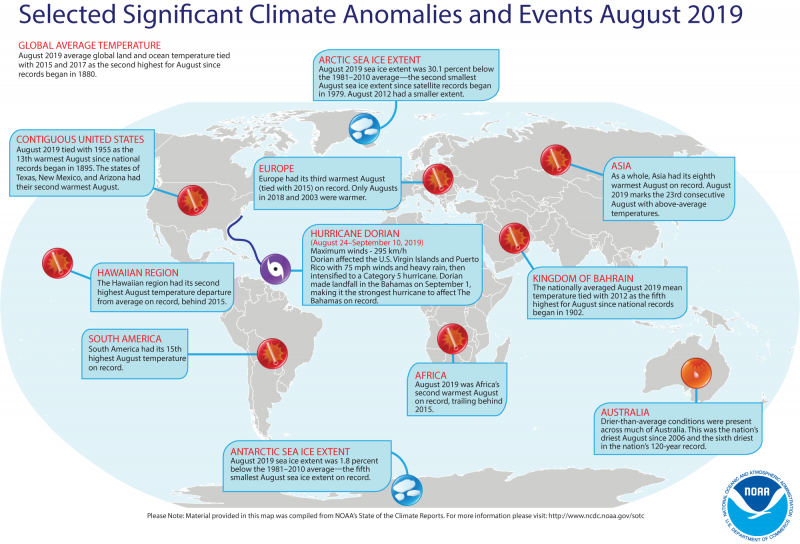

View larger.| Selected, significant climate anomalies and events, August, 2019. Scorching temps around the world made August 2019 as 2nd-hottest August on record, tied with 2015 and 2017. For details, see the short bulleted list below in our story. Image via NOAA.
According to NOAA report, released September 16, the 2019 Northern Hemisphere meteorological summer (June through August), is the hottest on in the 140-year climate record, tied with 2016. The 2019 Northern Hemisphere land and ocean surface temperatures for the period were 2.03 degrees F (1.13 degrees C) above average.
Meanwhile, June-August is the Southern Hemisphere’s winter, and this year’s Southern Hemisphere winter was tied with 2015 as the planet’s second hottest, after 2016, at 1.33 degrees F (.74 degrees C) above the 20th-century average. The last five June-August periods are the five hottest on record.
For the planet as a whole, NOAA reported that the period from January-August produced a global temperature that was 1.69 degrees F (.94 degrees C) above the 20th-century average of 57.3 degrees F (14.06 degrees C), making it the third hottest January-August period on record, after 2016 and 2017. The five warmest June–August periods have occurred in the last five years.
The global land and ocean surface temperature for the three-month season has increased at an average rate of .13 degrees F (.07 degrees C) per decade since 1880, according to NOAA, But since 1981, the average rate of increase is more than twice as great, at .32 degrees F (.18 degrees C) per decade.
NOAA said that the most notable warm temperature departures from average during June–August 2019 happened across much of the high latitudes in the Northern Hemisphere, specifically across the North Pacific Ocean, the Bering Sea, western Alaska, northern Canada, central Europe and north-central Russia. And Africa had its warmest June–August on record. No land or ocean areas had a record-cold June–August 2019 temperature.

View larger. | Image via NOAA.
Bottom line: NOAA reports that the 2019 Northern Hemisphere summer (June-August) was the hottest in the 140-year climate record.
from EarthSky https://ift.tt/34ZiaJ9


View larger.| Selected, significant climate anomalies and events, August, 2019. Scorching temps around the world made August 2019 as 2nd-hottest August on record, tied with 2015 and 2017. For details, see the short bulleted list below in our story. Image via NOAA.
According to NOAA report, released September 16, the 2019 Northern Hemisphere meteorological summer (June through August), is the hottest on in the 140-year climate record, tied with 2016. The 2019 Northern Hemisphere land and ocean surface temperatures for the period were 2.03 degrees F (1.13 degrees C) above average.
Meanwhile, June-August is the Southern Hemisphere’s winter, and this year’s Southern Hemisphere winter was tied with 2015 as the planet’s second hottest, after 2016, at 1.33 degrees F (.74 degrees C) above the 20th-century average. The last five June-August periods are the five hottest on record.
For the planet as a whole, NOAA reported that the period from January-August produced a global temperature that was 1.69 degrees F (.94 degrees C) above the 20th-century average of 57.3 degrees F (14.06 degrees C), making it the third hottest January-August period on record, after 2016 and 2017. The five warmest June–August periods have occurred in the last five years.
The global land and ocean surface temperature for the three-month season has increased at an average rate of .13 degrees F (.07 degrees C) per decade since 1880, according to NOAA, But since 1981, the average rate of increase is more than twice as great, at .32 degrees F (.18 degrees C) per decade.
NOAA said that the most notable warm temperature departures from average during June–August 2019 happened across much of the high latitudes in the Northern Hemisphere, specifically across the North Pacific Ocean, the Bering Sea, western Alaska, northern Canada, central Europe and north-central Russia. And Africa had its warmest June–August on record. No land or ocean areas had a record-cold June–August 2019 temperature.

View larger. | Image via NOAA.
Bottom line: NOAA reports that the 2019 Northern Hemisphere summer (June-August) was the hottest in the 140-year climate record.
from EarthSky https://ift.tt/34ZiaJ9

Aucun commentaire:
Enregistrer un commentaire